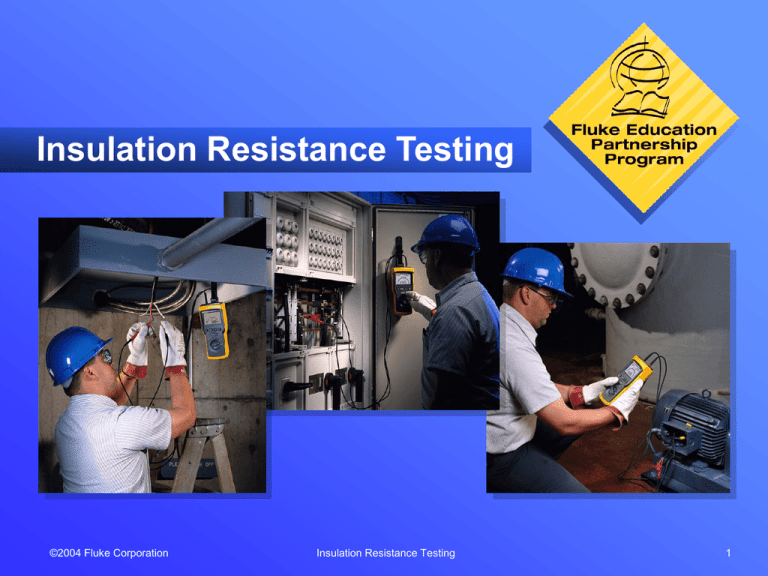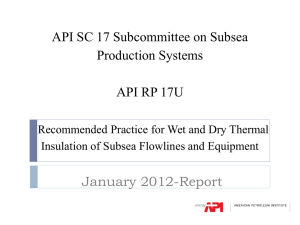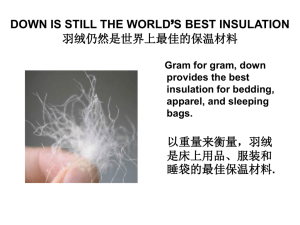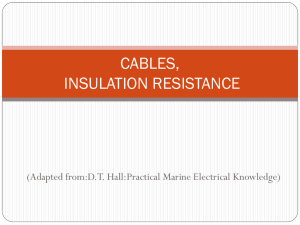Fluke MegOhmMeter Training
advertisement

Insulation Resistance Testing ©2004 Fluke Corporation Insulation Resistance Testing 1 Resistance 101 • Resistance is the opposition to current flow • Resistance is used to lower the amount of current and/or voltage flowing through a circuit • Unit of resistance is the ohm • Ohms symbol is omega: ©2004 Fluke Corporation Insulation Resistance Testing 2 What is megohm testing? • It’s testing for electrical insulation failure under controlled conditions • Used to determine the integrity of • • • • Cables Windings in motors and transformers Switching gear Electrical installations • Similar to pressure-testing a water pipe ©2004 Fluke Corporation Insulation Resistance Testing 3 Why different instruments read different ohms values • Ohmmeter (DMM) • Low voltage (~1-2V). • Low current (~1-10mA) . • MegOhmMeter • High voltages to stress the insulation. • Insulation Resistance Test (IRT). • Low Ohms Tester • Relatively high current (>200 mA). • Greater accuracy for low-resistance devices or conductors. ©2004 Fluke Corporation Insulation Resistance Testing 4 Leakage current basics • All insulators leak because all resistances conduct some current, however small • High voltages produce currents in insulators • The amount of current depends on • • • • Applied voltage (Ohm’s Law) System capacitance Total resistance Temperature of material ©2004 Fluke Corporation Insulation Resistance Testing 5 Components of leakage current • Polarization absorption leakage (IA) • Conductive leakage (IL) • Capacitive charging leakage (Ic) ©2004 Fluke Corporation Insulation Resistance Testing 6 Measuring insulation resistance • Customary: between two conductors “insulated” from each other • Worst case: tie one conductor to the conduit ©2004 Fluke Corporation Insulation Resistance Testing 7 Measuring insulation resistance Insulation resistance test ©2004 Fluke Corporation Insulation resistance test over time for a motor Insulation Resistance Testing 8 Be careful: I bite! • A 5 KV tester = up to 5200V DC output • Nonlethal, but potent • Limited to 2mA ©2004 Fluke Corporation Insulation Resistance Testing 9 Installation testing • Performed on these conductors • De-energized current-carrying (live) • Grounded • Grounding • When • Construction and maintenance • After initial installation • Why • #1 reason: Safety • Establish baseline ©2004 Fluke Corporation Insulation Resistance Testing 10 Maintenance testing Reasons for regular monitoring/testing • Predicts and identifies imminent failure • Prevents disaster • Lowers total cost of ownership Performed on critical conductors ©2004 Fluke Corporation Insulation Resistance Testing 11 Common voltages for testing Equipment Voltage Rating Test Voltage Up to 50 V 50 and 100 V Up to 100V 100 and 250V 440 to 550V 500 and 1,000V 2,400V 1,000 to 2,500V or higher 4,160V and above 1,000 to 5,000V or higher ©2004 Fluke Corporation Insulation Resistance Testing 12 Testing procedure To ensure proper installation and integrity: 1. Verify supply power is isolated/disconnected from system under test. 2. Select the appropriate voltage level. 3. Connect leads. 4. Take reading. 5. Allow discharge of test voltage 6. Test each conductor. ©2004 Fluke Corporation Insulation Resistance Testing 13 Using test results • Keep records • Analyze readings • Resolve issues • Monitor suspect cables ©2004 Fluke Corporation Insulation Resistance Testing 14 Spot-reading/Short-time test • Connection time: 60 seconds • Applies to low-capacitance equipment • Steady increase in resistance • One Megohm Rule of Thumb • Trending rates of decrease ©2004 Fluke Corporation Insulation Resistance Testing 15 Step voltage test Resistance testing at discrete voltage settings • Connection time: 60 seconds • When: After spot test • Looking for inconsistencies • Flaws show at steps ©2004 Fluke Corporation Insulation Resistance Testing 16 Step voltage test, good results ©2004 Fluke Corporation Insulation Resistance Testing 17 Step voltage test failure ©2004 Fluke Corporation Insulation Resistance Testing 18 Dielectric-absorption / time-resistance test Absorption characteristics: contaminated vs. good. • During first minute apply voltage every 10 seconds • Apply once a minute for 9 remaining minutes ©2004 Fluke Corporation Insulation Resistance Testing 19 Generator, motor, or transformer windings Check: • Winding to winding • Winding to ground • Phase to phase ©2004 Fluke Corporation Insulation Resistance Testing 20 Generator or motor windings • Disconnect stator winding and phases • Raise brushes for DC ©2004 Fluke Corporation Motor Nameplate Voltage Rating (v) Minimum Acceptable Resistance (ohms) 0-1000 1M 1000-2400 2M 2400-5000 3M Insulation Resistance Testing 21 Stop the presses! Newspaper printing press example • Initially: >500 M. • After a day or two: 10 M. • At about 1 M: rebuild the motor. 1000 100 10 1 0 ©2004 Fluke Corporation 100 Insulation Resistance Testing 200 300 400 22 Low ohms testing Connection quality check • Measure across connection • Typically less than 1 ohm • Requires lead compensation ©2004 Fluke Corporation Insulation Resistance Testing 23 Electrical contractors IR test applications: • • • • Leakage Cable insulation integrity Windings and switches Connections, fuses, breakers, and switches ©2004 Fluke Corporation Insulation Resistance Testing 24 Motor technicians IR test applications: • Leakage between windings • Leakage between windings and motor frame • When to test? ©2004 Fluke Corporation Insulation Resistance Testing 25 Plant maintenance IR test applications: • Wiring and cable • Contacts and connections • Grounding system integrity ©2004 Fluke Corporation Insulation Resistance Testing 26 Other users • Electrical Utility Workers • Low-voltage equipment • High voltage equipment • Elevator Technicians • Motors • Wiring • Controls ©2004 Fluke Corporation Insulation Resistance Testing 27 Final tips • Use the right tester • Follow the procedures • Analyze the results • Use proper trending • Take corrective action ©2004 Fluke Corporation Insulation Resistance Testing 28 1520/1550 MegOhmMeter optional hands-on exercises • Basic checks • Normal resistance test • Low resistance test • High resistance test ©2004 Fluke Corporation Insulation Resistance Testing 29 ©2004 Fluke Corporation Insulation Resistance Testing 30









